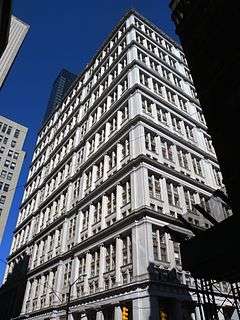195 Broadway
| 195 Broadway | |
|---|---|
 | |
| General information | |
| Status | Commercial Real Estate (Main Tenant: Thomson Reuters) |
| Type | Corporate headquarters |
| Location | New York, NY |
| Coordinates | 40°42′40″N 74°00′33″W / 40.7111°N 74.0093°WCoordinates: 40°42′40″N 74°00′33″W / 40.7111°N 74.0093°W |
| Owner | L&L Holding Company |
| Technical details | |
| Floor count | 29 |
195 Broadway is a 29-story building on Broadway in the Financial District of the New York City borough of Manhattan. It was the longtime headquarters of American Telephone and Telegraph, as well as Western Union for a time. It occupies almost an entire block on one side of Broadway, running from Dey Street to Fulton Street. It also has the address 15 Dey Street, well known as the site of one end of the first transcontinental telephone call. The same building, using the "195 Broadway" address, was the New York end of the first intercity Picturephone call in 1927[1] and of the first transatlantic telephone call, made to London, England, also in 1927.[2]
195 Broadway is also known as the Telephone Building, Telegraph Building, or Western Union Building, due to its history. The building is still in use. The 1987 film Wall Street used the building's ground floor lobby as Charlie Sheen's character's office.
Planning and construction
From 1885 to 1910, AT&T was headquartered at 125 Milk Street in Boston.[3]
The building at 195 Broadway was constructed under the leadership of AT&T's president Theodore Newton Vail, who had taken the AT&T helm in 1907 and added the same title at Western Union in 1909 when that firm was purchased by AT&T. In 1912, Vail developed a two-phase plan for a 29-story headquarters building that would be constructed on Broadway on the block stretching from Dey Street to Fulton Street. The plan entailed constructing one wing on the Dey Street corner, followed by the second wing on the Fulton Street corner.
The first portion of the building, the Dey Street wing completed in 1916, was an L-shaped structure at the corner of Dey Street and Broadway with an extension reaching Fulton Street.[2]
William W. Bosworth, the architect who designed the John D. Rockefeller estate at Kykuit, was commissioned to create the Fulton Street wing of the building. Bosworth's designed featured layers of gray granite columns in Doric and Ionic styles, and a lobby that included 43 oversized Doric columns made of marble.
Art
AT&T commissioned Evelyn Beatrice Longman to create a bronze sculpture that she called Genius of Telegraphy, that was to be placed atop a pyramidal structure on the top of the Fulton Street wing of the building. The statue that she created depicted a 24-foot-tall (7.3 m) winged male figure in gilded bronze on top of a globe, with the figure having cables around its torso and one of the statue's arms holding bolts of electricity. the statue was cast in bronze and covered with over 40,000 pieces of gold leaf.[4] After a court-ordered divestiture of Western Union, the statue's official title was changed to Genius of Electricity. The statue was renamed Spirit of Communication in the 1930s, but has been better known by its nickname, Golden Boy.[2]
One of sculptor Paul Manship's earliest public works was "The Four Elements," a set of four bronze reliefs that is on the lower facade of the building.[5]
Demise as headquarters
In 1978, AT&T commissioned a new building at 550 Madison Avenue. This new AT&T Building was designed by Philip Johnson and quickly became an icon of the new Postmodern architectural style. The building was completed in 1984, the very year of the Bell System divestiture. It proved to be too large for the post-divestiture corporation and in 1993, AT&T leased the building to Sony, who now owns it.[6]
Other features
The building includes an entrance to the Fulton Street station on the IRT Lexington Avenue Line (4 5 trains).
References
| Wikimedia Commons has media related to 195 Broadway. |
- ↑ TV History Two-Way Television by Bell Laboratories at 195 Broadway
- 1 2 3 Gray, Christopher. "Streetscapes/AT&T Headquarters at 195 Broadway; A Bellwether Building Where History Was Made", The New York Times, April 23, 2000. Accessed October 13, 2008.
- ↑ Jarzmbek, Mark. "Designing MIT: Bosworth's New Tech", UPNE, 2004, p. 161. Accessed October 13, 2004, via Google Books.
- ↑ Teltsch, Kathleen. "LANDMARK STATUE BEING RESTORED", August 31, 1981. Accessed October 11, 2008.
- ↑ Morrone, Francis. "An Icon of the City Gets an Opening", The New York Sun, November 3, 2006. Accessed October 13, 2008. "Manship's earliest public work in the city is the set of four bronze reliefs, The Four Elements, adorning the lower façade of 195 Broadway, one of the city's most beautiful skyscrapers, between Fulton and Dey streets."
- ↑ 550 Madison Ave.
.png)